
The National Black Theatre is a non-profit cultural and educational corporation, and community-based theatre company located on 5th Avenue in Harlem, New York.

The National Black Theatre is a non-profit cultural and educational corporation, and community-based theatre company located on 5th Avenue in Harlem, New York.
The National Black Theatre (NBT) is a non-profit cultural and educational corporation, and community-based theatre company born out of the civil rights movement to tell the stories of black theatre that did not often have a home in mainstream theatre. [1] Based in the Harlem neighborhood of the New York City borough of Manhattan, NBT was founded in 1968 by actress, director, producer, Dr. Barbara Ann Teer. [2] [3]
Dr. Teer founded the NBT with a goal of creating a "massive cultural and artistic movement to create people culturally literate." Teer viewed the African-American community as one that was in desperate need of an African cultural education. The company committed itself to representing and establishing "a black theatrical standard -- a standard based on black lifestyle." [4]
Teer turned the theatre into a cultural incubator that provided shows and workshops to help promote respect for the African ancestry and for black self-expression. [5] The NBT produced plays that were dedicated to raising the consciousness of the African-American community by crafting a distinct departure from White theatrical conventions. As Teer wrote in a critical essay, "You cannot have a theatre without ideology, without a base from which all of the forms must emanate and call it Black, for it will be the same as Western theatre, conventional theatre, safe theatre." [6] [7]
Notable productions performed at the NBT included Ritual, Change! Love Together! Organize! A Revival, Five on the Black Hand Side, The Believers, Softly Comes a Whirlwind, Whispering in Your Ear, and A Soul Journey into Truth. [8] Distinguished artists that have performed at the NBT include Nina Simone, Maya Angelou and Nikki Giovanni.
After Teer died in 2008, her daughter Sade Lythcott took over as CEO and to this day continues her leadership over the theatre. [9] It is one of the longest continually operating Black theatres in the United States. [10]
Once Sade Lythcott took over the role as CEO, one of the first challenges that was faced was the threat of the foreclosure of the theatre. [5] NBT was involved in various disagreements in regards with surrounding business including with the Applebee's franchise. These disputes had since been resolved. [5] The disputes has resulted in an over $10 million debt including their previous debts but was relieved when Baltoro Capital Management took over in the spring of 2012. [5] Since then, the management company has promised to keep the theatre rent-free even if the building was ever sold. [5]
While the theatre originally rented its space on 127th and East 125th Streets, [1] [11] Teer purchased the 8,000 square foot theatre in 1969 at 9 East 125th street. In 1982, the NBT expanded to a 64,000 square foot complex that housesd two theatres, classrooms, and an African and Nigerian art gallery. [1] [12]
In 2002, Barbara Ann Teer sold 49 percent of the property to Nubian Partners, which operated multiple retail outlets within the building. [13] In April 2009, Nubian Partners signed a lease with Apple-Metro which is an Applebee's Franchisee. [13] The franchise was planning to take on a lease in the building the National Black Theatre was located. Ms. Teer brought forth the case in early 2008, before her passing, arguing that Applebee's did not promote the cultural integrity mission that the theatre promoted. [13] This was a condition she included when she signed the real estate partnership agreement with Nubian in 2002 when the theatre was threatened by foreclosure. [13] Justice Walter B. Tolub, a judge for the New York County Supreme Court (Civil), ruled that leasing part of the building to Applebee's would be violating the contract between the two parties, National Black Theatre and Nubian Partners. [13] [14] On the afternoon of 15 July 2009, the State Supreme Court justice ruled that the Applebee's chain is not allowed to move into the building with the National Black Theatre. [13]
In 2021, the theatre announced that it would replace its building with a twenty-one-story one that contained housing, retail and a new theatre space that will open in 2024. [11]
Over the course of more than 300 productions, the National Black Theater has earned more than 45 AUDELCO Black Theatre Excellence Awards, and continues to be a successful institution of African-American theater. [15]
By 1986, the theatre was recognized as one of the most important arts institutions in America by President Ronald Reagan. [2] [15] Former New York State Governor Mario Cuomo acknowledged The National Black Theatre as "one of New York State’s greatest cultural treasures and resources and a cornerstone for the revitalization of 125th Street."

The Apollo Theater is a multi-use theater at 253 West 125th Street in the Harlem neighborhood of Upper Manhattan in New York City. It is a popular venue for black American performers and is the home of the TV show Showtime at the Apollo. The theater, which has approximately 1,500 seats across three levels, was designed by George Keister with elements of the neoclassical style. The facade and interior of the theater are New York City designated landmarks and are listed on the National Register of Historic Places. The nonprofit Apollo Theater Foundation (ATF) operates the theater, as well as two smaller auditoriums at the Victoria Theater and a recording studio at the Apollo.

The Black Arts Movement (BAM) was an African American-led art movement that was active during the 1960s and 1970s. Through activism and art, BAM created new cultural institutions and conveyed a message of black pride. The movement expanded from the incredible accomplishments of artists of the Harlem Renaissance.
Charlie Louis Russell, Jr. was an American writer, best known for his play, Five on the Black Hand Side, which was later made into an acclaimed motion picture.
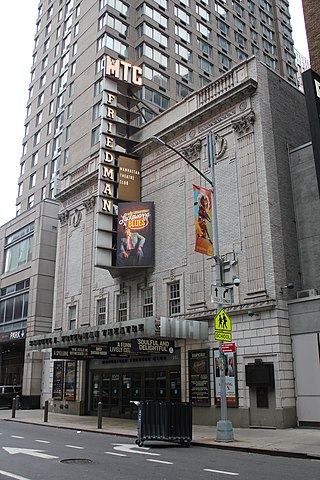
The Samuel J. Friedman Theatre, formerly the Biltmore Theatre, is a Broadway theater at 261 West 47th Street in the Theater District of Midtown Manhattan in New York City. Opened in 1925, it was designed by Herbert J. Krapp in the neo-Renaissance style and was constructed for Irwin Chanin. It has 650 seats across two levels and is operated by the Manhattan Theatre Club (MTC). The auditorium interior is a New York City landmark, and the theater is listed on the National Register of Historic Places. Since 2008, the theater has been named for Broadway publicist Samuel J. Friedman, whose family was a major donor to MTC.

The American Airlines Theatre, originally the Selwyn Theatre, is a Broadway theater at 227 West 42nd Street in the Theater District of Midtown Manhattan in New York City. Built in 1918, it was designed by George Keister and developed by brothers Edgar and Archibald Selwyn, for whom the theater was originally named. The theater is owned by the city and state governments of New York and leased to New 42nd Street. It has 740 seats across two levels and is operated by Roundabout Theatre Company. Since 2000, the theater has been named for American Airlines (AA), which bought the theater's naming rights.
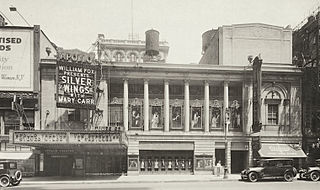
The Times Square Theater is a former Broadway and movie theater at 217 West 42nd Street in the Theater District of Midtown Manhattan in New York City, near Times Square. Built in 1920, it was designed by Eugene De Rosa and developed by brothers Edgar and Archibald Selwyn. The building, which is no longer an active theater, is owned by the city and state governments of New York and leased to New 42nd Street.

1585 Broadway, also called the Morgan Stanley Building, is a 42-story office building on Times Square in the Theater District neighborhood of Manhattan in New York City. The building was designed by Gwathmey Siegel & Associates Architects and Emery Roth & Sons and was developed by David and Jean Solomon. 1585 Broadway occupies a site on the west side of Broadway between 47th and 48th Streets. The building has served as the headquarters of financial-services company Morgan Stanley since 1995.
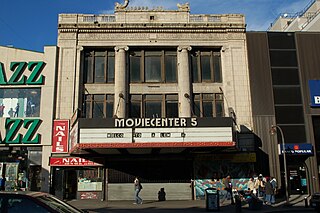
The Victoria Theater was a theater located on 125th Street in the Harlem neighborhood of Manhattan in New York City. It was designed in 1917 by Thomas W. Lamb, a notable and prolific theater architect of the era, for the Loew's Corporation. It was largely demolished in 2017, with the facade and lobby retained as part of a new mixed-use skyscraper, the tallest building in Manhattan north of Central Park.
Black Horizons Theater was a community-based, Black Nationalist theater company co-founded in 1968 by Curtiss Porter, Tony Fountain, E. Philip McKain, August Wilson and Rob Penny in the Hill District of Pittsburgh, Pennsylvania, United States.
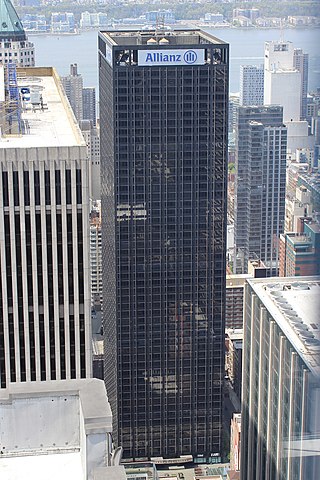
Paramount Plaza, also 1633 Broadway and formerly the Uris Building, is a 48-story skyscraper in the Midtown Manhattan neighborhood of New York City. Designed by Emery Roth and Sons, the building was developed by the Uris brothers and was renamed for its owner, the Paramount Group, by 1980. Paramount Plaza occupies a site bounded by Broadway to the east, 51st Street to the north, and 50th Street to the south.

The Candler Building is a skyscraper at the southern end of Times Square in the Midtown Manhattan neighborhood of New York City. Located at 220 West 42nd Street, with a secondary address of 221 West 41st Street, the 24-story building was designed by the firm of Willauer, Shape and Bready in the Spanish Renaissance style. It was constructed between 1912 and 1913 for Coca-Cola Company owner Asa Griggs Candler. The Candler Building was one of the last skyscrapers built in New York City before the 1916 Zoning Resolution, which required setbacks. It is listed on the National Register of Historic Places (NRHP).
Crossroads Theatre is an American residence theater company in New Brunswick, New Jersey focused on the Black American experience and the African diaspora. It is in residence at the newly built New Brunswick Performing Arts Center, which opened in the city's Civic Square in 2019.

1501 Broadway, also known as the Paramount Building, is a 33-story office building on Times Square between West 43rd and 44th Streets in the Theater District neighborhood of Manhattan in New York City. Designed by Rapp and Rapp, it was erected from 1925 to 1927 as the headquarters of Paramount Pictures. The building is designed in the Art Deco and Beaux-Arts styles. The office wing on Times Square contains numerous setbacks as mandated by the 1916 Zoning Resolution, while the rear wing housed the Paramount Theatre from 1926 to 1967. Newmark & Company owns 1501 Broadway.
Barbara Ann Teer was an American writer, producer, teacher, actress and social visionary. In 1968, she founded Harlem's National Black Theatre, the first revenue-generating black theater arts complex in the U.S.
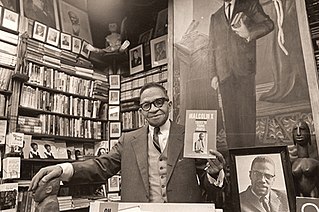
Lewis H. Michaux was a Harlem bookseller and civil rights activist. Between 1932 and 1974 he owned the African National Memorial Bookstore in Harlem, New York City, one of the most prominent African-American bookstores in the country.
Michael F. Lythcott is an American entrepreneur and investor who has founded several media and internet companies. He is the son of Barbara Ann Teer who founded Harlem's National Black Theatre in 1968, and the grandson of former Assistant Surgeon General George I. Lythcott.

Village East by Angelika is a movie theater at 189 Second Avenue, on the corner with 12th Street, in the East Village of Manhattan in New York City. Part of the former Yiddish Theatre District, the theater was designed in the Moorish Revival style by Harrison Wiseman and built from 1925 to 1926 by Louis Jaffe. In addition to Yiddish theatre, the theater has hosted off-Broadway shows, burlesque, and movies. Since 1991, it has been operated by Angelika Film Center as a seven-screen multiplex. Both the exterior and interior of the theater are New York City designated landmarks, and the theater is on the National Register of Historic Places.
Melanie Person is an American dancer, choreographer, and educator who began her career at 14 as a "baby ballerina" with the Dance Theatre of Harlem. She is currently the co-director of the Alvin Ailey American Dance Theater's Ailey School, with Tracy Inman.
Culture at 3, stylized as Culture @ 3, is a call with Cultural organizations in New York City that grew out of the city's shutdown due to the COVID-19 pandemic. It is believed to be the first time the arts and cultural organizations of all genres have come together to address issues facing the cultural community.
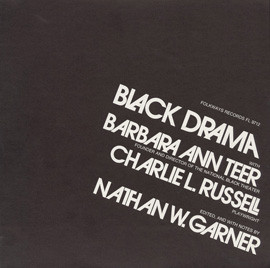
Black Drama is a two-track American spoken word record featuring two autobiographical accounts from Barbara Ann Teer and Charlie L. Russell, both leading African American figures in live theater during the 1970s. It was distributed by Smithsonian Folkways Recordings in 1973 and details their individual rises to significance in the live theatre scene of the time. It was issued via LP record on January 1, 1973. A cassette tape release of the recording was issued in 1994.
{{cite web}}: CS1 maint: numeric names: authors list (link)